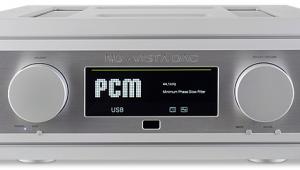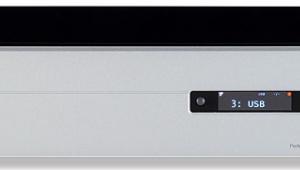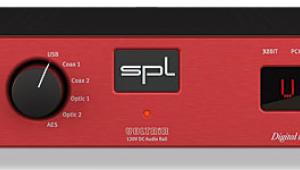Prism Sound Orpheus (£3495)
If you agree with me that optical disc replay – whatever the colour of laser it uses – is yesterday’s audio technology, there are numerous different ways to replay music from hard disk instead, some of which don’t even involve having a computer in the listening room. But if you insist on being able to play both stereo and multichannel files in hi-res then the options begin to dry up. If you’re content to use a desktop computer as your audio source then you can, of course, fit a multichannel sound card to one of its expansion slots. But if you insist on a computer that’s more compact and pleasing to the eye – something like the Mac mini, which is less aesthetically challenged than even a laptop – then you’ll need an external audio interface. USB-connected DACs abound but none that I know of reaches out to 24-bit/192kHz and most if not all are stereo. So they’re no use. Instead you have to look to multichannel FireWire interfaces, the best of which support 24/192 on eight or more channels.
A FEW DRAWBACKS…
Fine, but these devices are intended for professional use, which has a number of more or less undesirable consequences for the audiophile. First: they rarely feature in hi-fi magazines so they are mostly an unknown quantity. Second: they usually feature analogue inputs as well as outputs, ie, they are recording as well as playback devices, which means, for most of us, that half of their capability is redundant. Third: because they are intended for use in a studio context they typically look functional to the point of ugliness in a domestic audio system. And fourth: they often don’t incorporate a global software volume control; and what control they do provide is via on-screen sliders. Which means, in effect, that you have to have a multichannel preamp downstream. In my case I’ve built an eight-channel passive pre- based on a DACT eight-gang stepped attenuator, but it still involves extra cabling and connections I’d prefer to be without.
You can imagine, then, that my eyes lit up when someone first alerted me to the Prism Sound Orpheus. First point in its favour: Prism has an excellent reputation for its professional converters, engineer/producer George Massenburg being but one of its big-time advocates. Second: someone has actually styled the Orpheus fascia rather than just closing their eyes and throwing knobs at it. With the optional rack-mount ‘ears’ removed, it is handsome enough to blend into any domestic audio system and not call the wrong sort of attention to itself – except, perhaps, for its excess of front panel LED indicators and hopeless level meters, although the latter can at least be disabled. And third: yes, your eyes do not deceive you, that’s a volume control knob on the front panel. And not just a crude potentiometer, instead a shaft encoder which controls volume in the digital domain.
Still, there are flies in the ointment when the Orpheus is used away from its intended studio environment – and so to yet another list! First: the Orpheus incorporates eight channels of input as well as eight channels of output, which most audiophiles won’t need. Second: the outputs are on balanced quarter-inch jacks – not exactly a common domestic audio connection standard, but one that’s demanded in this case by pro requirements and the limited amount of real estate on the back panel. Taking an unbalanced output using a mono jack plug or adaptor is accommodated, though.
Third and more seriously: there are issues re FireWire connection, although to be fair these affect other FireWire audio interfaces too. In the first place, many of today’s computers don’t incorporate a FireWire interface as standard, in which case one will have to be added. With a laptop this will usually be via an ExpressCard adaptor; in a desktop computer a PCI or PCIe expansion card can be used instead and is often cheaper.
Whichever type of adaptor is chosen, it should use a TI (Texas Instruments) FireWire chip since this is the one recommended by most audio interface manufacturers. Other chips may not work correctly. I tried running the Orpheus from a Toshiba laptop using both its internal FireWire chip (TI) via 4-pin (iLink) output socket and a Sonnet FireWire 800 Pro ExpressCard adaptor (also with a TI chip) and it worked fine in both instances under Windows Vista. Likewise when I tried my Dell Inspiron measurement computer as the signal source via an HP Adaptec FireConnect 2100 PCI card, which is also TI-toting. This computer dual-boots Vista and XP Pro SP3, both of which I used successfully, in all cases with Foobar2000 as the audio player.
AND PROBLEMS WITH MACS
Where I ran into problems – as users of other FireWire audio interfaces have done too – was using the latest-generation Mac mini which serves as my usual hard-disk audio source. And it’s not just that a Firewire 400 to 800 adaptor is needed to connect the Orpheus to the mini. Rather, Current Apple computers use an LSI (formerly Agere) FireWire chip which can give problems if your Mac runs Windows, as mine does by preference (XP Pro). Apple claims that this is a Windows bug, which may be true but does nothing to alleviate the frustration of Mac owners having difficulty accessing their audio interface when running a Microsoft OS.
I had already experienced problems with an RME Fireface 800, which wouldn’t play 24/192 files, but this was fixed – as described in RME’s online forum – by adding a Lindy FireWire extension cable. Mysterious but true.
Any hope that this deus ex machina might also enable bug-free conversation between the Mac mini and Orpheus proved, unfortunately, to be wishful thinking. With or without the Lindy extension, the Orpheus would crash Windows boot-up if connected and would occasionally initiate a blue screen episode when, after boot-up, it was connected and configured using its software utility.
Most of the time, though, it worked OK when used in this way, and so this is how I conducted the review listening – having first satisfied myself that nothing untoward was happening to sound quality by comparing results with those obtained via the Dell. Nevertheless, the Mac mini/Orpheus combination is not a happy one: I know someone with a later version of XP Pro installed on his mini (SP3 as opposed to my SP2 with the hotfix for FireWire speed) who just cannot get his Orpheus to work with it. He uses Mac OS X instead.
Compare the Orpheus’s price to that of many other FireWire audio interfaces and you’ll see that it occupies the premium end of the market. The RME Fireface 800, with which I compared it, is similarly equipped but can be bought for less than a third of the price online. So the Orpheus needs to provide cut-above sound quality to match its cut-above entry fee – and this it most certainly does.
No initial driver comparison was required because, although the Orpheus is supplied with an ASIO driver, Foobar2000 doesn’t see it for some reason, nor does the Orpheus support the Kernel Streaming option (which bypasses XP’s much-vilified Kernel Mixer). So the only functional output mode from Foobar is Direct Sound.
EYE WATERING
Hard-disk audio – particularly when computer-driven – changes the way you listen to music, and not necessarily for the better as it becomes so easy to listen to individual tracks rather than complete albums. As a means of assembling a pot-pourri of music for review listening, though, it’s wonderful. No searching through racks of CDs trying to remember what the spine design looks like; no triumphant opening of a caddy only to find that the disc itself is skulking in a player tray somewhere else.
One of the first tracks I selected, with last month’s review of the Naim Audio HDX still fresh in my mind, was ‘Annie’s Yellow Bag’ from Gwyneth Herbert’s All the Ghosts [naimcd135]. As I explained in that review, the bass and drum opening of this track should hit you smack between the eyes, otherwise something vital is lacking in your system’s DNA.
No question, the Orpheus made my eyes water in a way the RME could not – whether Direct Sound or ASIO drivers were used with it. It wasn’t just that the Orpheus had the greater weight of punch: rhythmically it was more assured, and its vocal clarity and tight control of elements within the soundstage were superior too. So did the Orpheus match the HDX here? I wouldn’t trust my audio memory sufficiently to call it either way, but there’s no question it was there or thereabouts.
VIOLIN WITH ORCHESTRA
Intriguingly, one of the clearest demonstrations of the Orpheus’s superiority came while I still had the Sennheiser HD 800 headphones on review, and was driving them with the sublime Lehmann Black Cube headphone amplifier [HFN Oct ’09]. For some reason I was inspired to play (from the CD layer of DG 474 8732) Hilary Hahn’s fine performance of Vaughan Williams’s elegiac The Lark Ascending with the LSO under Sir Colin Davis, with which the Orpheus and Fireface 800 were chalk and cheese. As well as conjuring up a larger soundstage and an ideal balance of warmth and clarity in the orchestral contribution, the Orpheus had a profound effect on the sound of Hahn’s violin, in particular the character and believability of its body sound as the bow was drawn over the strings. It was a captivating rendition of a moving performance, one which the RME fell significantly short of matching.
At this juncture, rather than continuing to diss the cheaper Fireface 800 – which is a remarkable value product in its own right – let me just record that the Orpheus’s clear sonic superiority was maintained throughout my listening. Which took me next, on a whim, to something I haven’t listened to for many months: Andrzej Panufnik’s Violin Concerto, recorded in 1990.
I’ve liked and admired this piece ever since I heard it performed in the related concert but – perhaps because it was (supposedly) recorded on Technics DAT machines – I’ve always found the recording [Conifer, now deleted] a little lacklustre. I doubt that anything short of a minor miracle could make it sound great, but the Orpheus did a fine job of removing some of the orchestral obfuscation in the first movement and shoring up the rhythmical drive of the third. And as for the hauntingly beautiful but restless second movement: I have never heard it imbued with such an unsettling undertone before; I really must play this more often, I thought.
ON TO ELP
Bombastic rock music fared well via the Orpheus too. Seeing JB’s mention of ‘Karn Evil 9’ in the December issue set me looking out some real ELP, which to my mind means anything before lost-the-plot ‘Brain Salad Surgery’. I recall a Melody Maker journalist (I think it was) describing how in an Irish pub after a gig with the Bonzo Dog Band, Keith Emerson beat the incumbent upright piano black and blue while Legs Larry Smith sang bawdy songs. I wish that performance were on tape but, failing that, you can do a lot worse than relive the first ‘side’ of Tarkus if you want to revel in Emerson’s ability to contrive a deceptively simple solo theme and develop it in a way that every other rock keyboardist has found inimitable. (Don’t even mention Rick Wakeman in this household.)
Yes, some of the lyrics are fatuous, and no, I don’t pray for a return of the pomp rock era. But I don’t mind admitting that, with the able assistance of the Orpheus, I thoroughly enjoyed re-immersing myself in the Tarkus epic and the relentless virtuosic invention that drives it. ‘Stones Of Years’ with its patiently constructed Hammond solo; ‘Mass’ with its wicked bass synth riff; and the Bolero-like ‘Aquatarkus’ with its martial drumming underpinning and then overwhelming the machine-like synth sounds in either channel: a harmonically challenging ground on the left and increasingly frenetic improvisation on the right. All were rendered as well as I’ve ever heard them. My only regret: that I could never make it sound like this in the early 1970s (but then what could you expect of a BSR McDonald MP60?). I think you know the rest. When the Orpheus returns home to Prism Sound HQ in Cambridgeshire, I will mourn its departure.
VERDICT
Although never intended to be a domestic audio product, the Prism Sound Orpheus makes a better job than most professional FireWire audio interfaces of blending into a home audio system. If you demand multichannel capability from hard disk at up to 24/192, this is the way to get it – and the Orpheus delivers sound quality to justify its price premium. In audiophile terms, it’s great value for money.
Sound Quality: 85%



















































